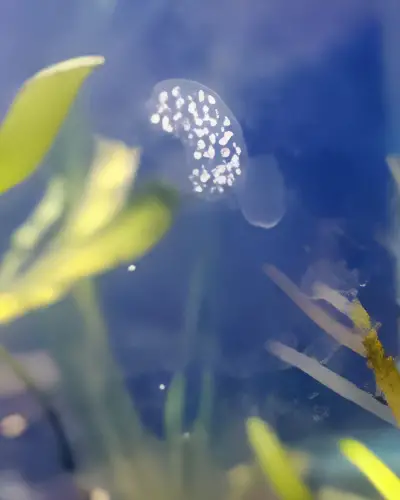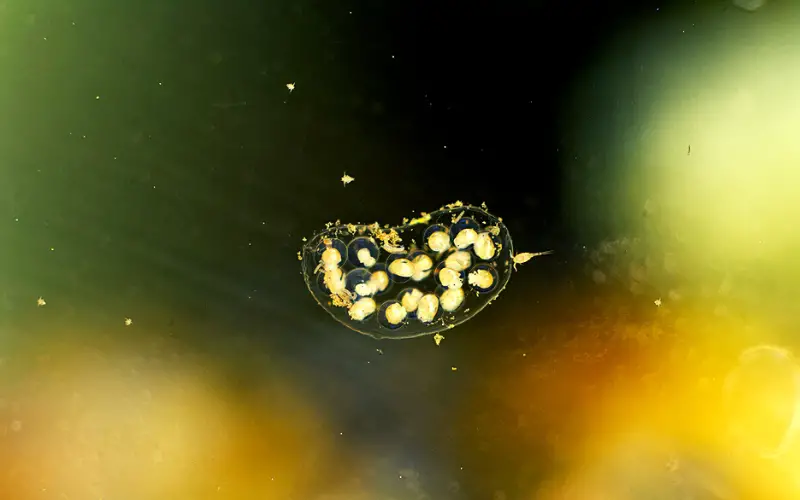What do assassin snail eggs look like? Assassin snails are popular for aquarium enthusiasts due to their unique appearance and beneficial role in controlling pest snail populations. If you have a pair of assassin snails in your aquarium, you may come across the tiny eggs they lay.
While hatching assassin snail eggs can be challenging, with the proper knowledge and a few simple steps, you can successfully hatch and raise these miniature predators in your own aquarium.
In this assassin snail care article, we will provide a step-by-step guide on hatching assassin snail eggs in your aquarium.

From identifying the eggs to creating the perfect environment for hatching, we will cover all the necessary information you need to know.
Following these tips and tricks, you can enjoy watching your baby assassin snails grow and thrive in your aquatic habitat.
Table of Contents
ToggleWhat Do Assassin Snail Eggs Look Like?
Assassin snail eggs are small, gelatinous, and white in color. They are usually laid on hard surfaces such as the sides of the tank, plants, snail shells, or substrates. The eggs can be easily mistaken for pond snail or ramshorn snail eggs, so it’s essential to keep an eye out for them.
Each batch of eggs can contain only one assassin snail egg to several dozen eggs. They are generally safe from fish and shrimp that might feed on them.
If you find assassin snail eggs in your tank, you might want to remove them to prevent their population from growing and potentially causing harm to other snail populations in the tank.

Depending on the water parameters and conditions in the tank, it may take a few weeks to several months for the eggs to hatch and mature.
One way to help keep snail populations in check is by adding assassin snails to a tank with an empty snail or a small colony of pest snails.
Assassin snails prefer eating other snails to help decimate unwanted snail populations. If you have a planted tank with live plants, make sure the tank is stable and the plants are healthy.
Assassin snails may also burrow in the substrate and hide during the day, so ensure they have enough hiding spots. They generally prefer peaceful tank mates like Cory fish and shrimp.
Remember that assassin snails will also feed on fish flakes, protein pellets, and other food sources you might need to provide.
Assassin Snail Eggs: How Long to Hatch?
Assassin snail eggs typically take around two months to hatch. The exact time can vary depending on the water temperature, with warmer water leading to slightly faster development.
The eggs undergo various developmental stages during this incubation period, visible through their translucent shells. Once hatched, the baby assassin snails will be tiny and transparent, likely burrowing into the substrate to start feeding.
What Conditions Are Ideal for Assassin Snail Eggs to Hatch?
Assassin snail eggs are delicate and require the right conditions to hatch successfully. One of the ideal conditions for assassin snail eggs to hatch is a shrimp tank that is well-established and has a stable environment.
The tank should have consistent water quality with low ammonia, nitrite, and nitrate levels. Additionally, regular water changes should be performed to maintain optimal conditions for hatching. Another critical factor is the presence of tiny snails for the hatchlings to feed on.
Including rocks, gravel, or other decorations in the tank can provide hiding places for laying eggs. Overall, ensuring that the tank environment is stable and suitable for these scavenger creatures will increase the chances of successful breeding.
Here are the ideal water tank conditions for A Healthy assassin snail eggs to hatch:
- Freshwater: Assassin snails are freshwater snails, so their eggs need to be submerged in freshwater to hatch. The water should be good quality and free of chlorine and other harmful chemicals. You can use aged tap water or bottled spring water.
- Temperature: The ideal water temperature for hatching assassin snail eggs is 72-78 degrees Fahrenheit (22-26 degrees Celsius). Temperatures outside this wide range will slow down or prevent hatching.
- Cleanliness: The container where the eggs are should be clean and free of debris or waste products. This will help to prevent the eggs from becoming infected with bacteria or fungus.
- Moisture: The eggs must be kept moist but not too wet. If the eggs are too dry, they will not develop properly. You can achieve the correct moisture level by placing a damp paper towel in the container with the eggs.
- Minimal disturbance: It is best to leave the eggs undisturbed as much as possible during incubation. Handling the eggs too much can stress the developing embryos and decrease the hatching rate.
The incubation period for assassin snail eggs is typically 3-4 weeks. Once the eggs hatch, the baby snails will be tiny and transparent. They must be fed infusoria or other very small food particles until they are large enough to eat different foods.
Breeding Assassin Snails: How to Hatch Assassin Snail Eggs (Step-By-Step)
Assassin snails are a popular choice for many hobbyists due to their ability to control pest snail populations in home tanks. These snails are generally easy to breed, making them an excellent option for those looking to start breeding them in their tanks.
If you find eggs in your tank, it’s essential to know how to hatch them properly to ensure the survival of the baby snails.
One method to hatch assassin snail eggs in my tank involves placing them in a separate container with a gallon of water from the main tank and adjusting the water parameters to match their natural habitat.
Keeping the water clean and maintaining a stable temperature is essential to give the baby snails the best chance of survival.
Another issue to consider when hatching assassin snail eggs is sudden changes in water parameters, which can be detrimental to the developing snails.
It’s important to acclimate them slowly to their new environment to prevent this. It’s also a good idea to provide a source of food for the baby snails to eat once they hatch, such as small specks of fish food or algae wafers.
Following these steps, you can successfully hatch assassin snail eggs in your home tank and enjoy watching the baby snails grow and thrive.
Common Assassin Snail Tank Mates
Despite their name, Assassin snails are generally peaceful creatures when it comes to tank mates. However, being carnivores, there are some things to remember when choosing their companions.
Good Tank Mates:
- Community Fish: Most peaceful community fish like neon tetras, Corydoras catfish, angelfish, celestial danios, and cherry barbs can safely co-exist with assassin snails. These fish are too fast or too large for the slow-moving assassins to prey on.
- Peaceful Scavengers: Bottom feeders like Corydoras catfish and Otocinclus catfish are good tank mates for assassin snails as they occupy different niches in the tank and won’t compete for food or space.
- Larger Shrimp: While assassin snails are known to eat smaller shrimp, they can be kept with larger, faster-moving varieties like Amano shrimp, ghost shrimp, bamboo shrimp, and viper shrimp, as long as the assassins are well-fed and the tank is spacious enough.
- Clams: Freshwater clams, small and larger snails, are generally compatible with assassin snails.
Tank Mates to Avoid:
- Aggressive Fish: Fish known for being fin nippers or aggressive towards other tank mates, like goldfish, cichlids, and crayfish, should be avoided as they can injure or even kill assassin snails.
- Small Shrimp: Any shrimp species smaller than the assassin snail is at risk of being preyed upon, especially if the snail is hungry.
Remember, even with compatible tank mates, it’s always a good practice to observe the behavior of your fish and snails to ensure everyone is thriving in the shared environment.
Commonly Asked Questions about Assassin Snail Eggs Hatching (FAQs)
Where do assassin snails lay their eggs?
Assassin snails lay their eggs one at a time on hard surfaces like aquarium glass, driftwood, or rocks. These yellowish eggs are encased in a translucent, rectangular capsule.
Do assassin snails eat snail eggs?
Assassin snails primarily target live snails but may eat soft snail eggs, not the hard-shelled variety like Nerite eggs. They generally avoid their own eggs and those of their own species.
Do assassin snails lay eggs?
Assassin snails reproduce by laying single eggs on hard surfaces in aquariums. These snail species eggs are encased in a clear, rectangular capsule and hatch after several weeks.
How many eggs do assassin snails lay?
Assassin snails lay one egg at a time but may lay many eggs over time. These individual eggs are often laid in close clusters on hard surfaces in the aquarium.
How often do assassin snails lay eggs?
The frequency of assassin snail egg-laying is uncertain due to varying factors like age, health, and food availability. However, they can lay eggs every few days under ideal conditions.
Can a single assassin snail reproduce?
No, assassin snails require both a male and a female to reproduce. A single assassin snail cannot lay fertilized eggs.
Are assassin snails venomous?
No, assassin snails are not venomous. They use a sharp proboscis to pierce and eat their prey, not inject venom. They are safe for humans and most fish.
How do you identify a baby assassin snail?
Baby assassin snails resemble miniature adults with a similar elongated, striped shell. They are tiny, roughly the size of a grain of rice when newly hatched.
Will assassin snails kill Malaysian trumpet snails?
Absolutely! Assassin snails are specialists in hunting and eating other snails. They’re a popular choice for aquarists looking to control populations of Malaysian trumpet snails.
Conclusion
In conclusion, hatching an assassin snail egg in your aquarium can be a rewarding and fascinating experience. You can increase the chances of successful hatching by providing the right conditions, such as a stable water temperature and quality, along with ample hiding spots. Remember to be patient and vigilant during this process, as it may take some time for the eggs to hatch. Once they do, you’ll be greeted with the tiny yet powerful new additions to your aquatic ecosystem. So, if you’re ready to dive into the world of assassin snails and witness the miracle of life, get ready to hatch those assassin snail eggs and see nature’s wonders unfold before your eyes. Custom shoulder boxes, client’
You might also like
- Assassin Snail 101: Comprehensive Aquarium Guide (Exclusive)
- Do Snails Eat Fish Poop in Aquarium: (The Truth Revealed)
- TOP 5 Best Snails for Betta Tank: (That Can Live Safely)
- Assassin Snail Breeding 101: A Comprehensive Beginners Guide
- What Do Assassin Snails Eat in Aquarium: A Comprehensive Feeding Guide
- How Do Assassin Snails Kill Their Prey: Unveiling Their Deadly Secrets!
- Will Assassin Snails Eat Shrimp: the Ultimate Coexisting Guide
- Warning: Assassin Snail Tank Size Reveals Deadly Secret Weapon!
- How Fast Do Assassin Snails Breed in Tanks: (Ultimate Guide)
- Do Assassin Snails Reproduce Asexually: (The Shocking Truth)
- How Do Assassin Snails Reproduce: (Tank Care & Breeding Tips)
- How Often Does Assassin Snail Lay Eggs: (Ultimate Guide)





